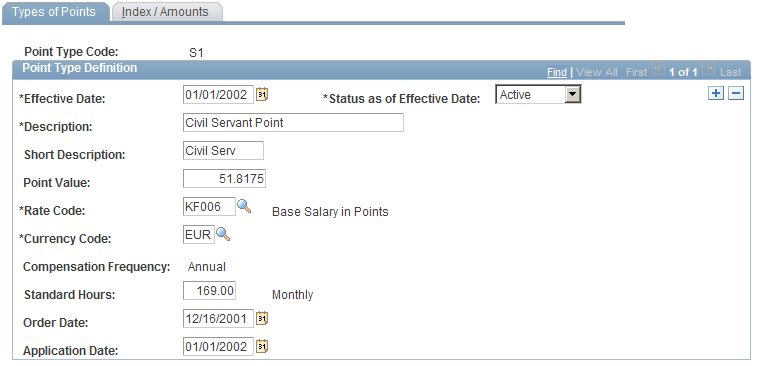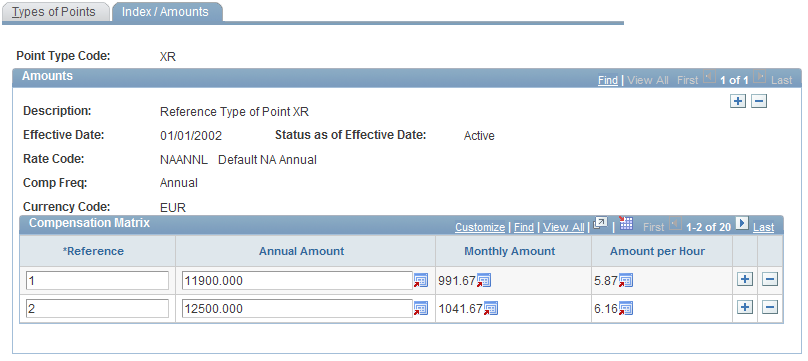Defining Types of Points
To define types of points, use the Types of Points component (FPMPOINTYP_PNL). This section provides an overview of points and discusses how to define them.
|
Page Name |
Definition Name |
Usage |
|---|---|---|
|
FPMPOINTYP_PNL |
Add or change point types. |
|
|
FPMINDEXAMT_PNL |
Set up the relationship between the reference and the amount. |
You use points to calculate compensation amounts associated with various increased indexes or references. You can create several point types that correspond to various populations.
There are two general types of points in Manage French Public Sector:
Those that set up compensation grids with references.
In this case, the type of point must begin with the letter X. The grid is filled in manually.
Those that automatically set up compensation grids taking into account increased indexes and the point value (for civil servants, this value is determined by an order).
This is the general type of point.
Use the Types of Points page (FPMPOINTYP_PNL) to add or change point types.
Navigation
Image: Types of Points page
This example illustrates the fields and controls on the Types of Points page. You can find definitions for the fields and controls later on this page.

|
Field or Control |
Definition |
|---|---|
| Point Type Code |
Displays the point type code. Codes prefixed with an X are those that set up compensation grids with references. Codes without this prefix are general types of points. |
| Point Value |
Enter a point value for a general type of point. This field is not for points with the X prefix. |
| Rate Code |
Select a rate code value to calculate the compensation amounts. If it is a general type of point, the system displays only points rate codes (instead of flat amount rate codes) with an annual frequency. If the point type code is prefixed by X, the system displays only flat amount rate codes with annual, monthly, or hourly frequency. |
| Standard Hours |
Enter a standard hours value to calculate the compensation amounts. |
| Order Date |
Enter the order date. The order date is the date that the decree setting the point value is issued. |
| Application Date |
Specify the application date. For example, assume that a decree setting up a new point value is issued on 1 July 2006 (order date) and that the decree states that the new value is applicable as of 1 August 2006 retroactive to 1 January 2006. In this case, 1 August would be the application date and 1 January would be the effective date. |
Note: There is PeopleCode—located in the FPMPOINTYP_TBL record, EFFDT.RowInit event—to generate all increased indexes for general types of points.
Use the Index / Amounts page (FPMINDEXAMT_PNL) to set up the relationship between the reference and the amount.
Navigation
Image: Index / Amounts page
This example illustrates the fields and controls on the Index / Amounts page. You can find definitions for the fields and controls later on this page.

For each point type, the system displays the associated rate code, currency, and frequency. Click the Add button to add a new row if required.
To set up the reference grid:
Enter an annual amount, a monthly amount, and/or an amount per hour according to the frequency that is defined for the rate code.
Depending on the frequency of the selected rate, you can enter one amount—either the hourly, the monthly or the annual one. The other two amounts are display only.
For each amount, you can obtain a correspondence in another currency either by triangulation or by direct calculation.
Click the Display in Other Currency button for direct calculation.
The amounts in the display only fields are automatically calculated.
The amounts are calculated for the frequencies that are delivered by PeopleSoft (hourly, monthly, annual) and according to standard hours.